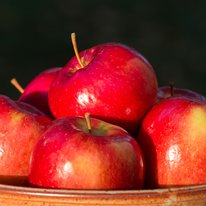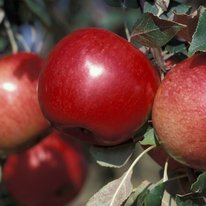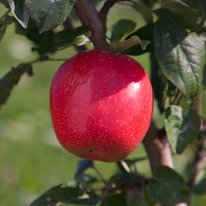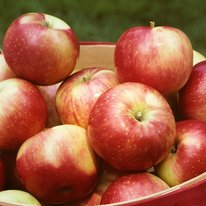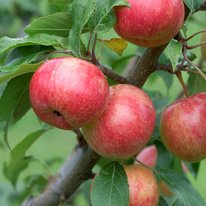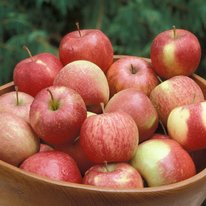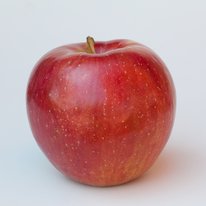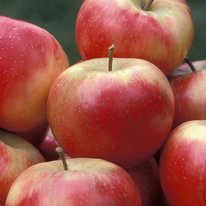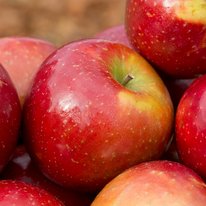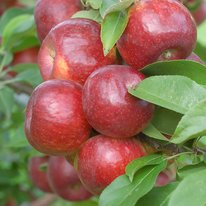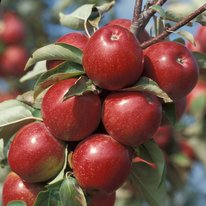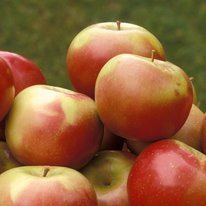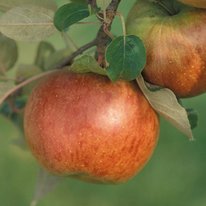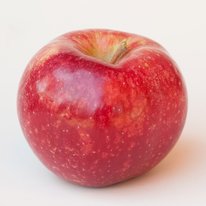Since the apple breeding program began at the University of Minnesota in 1878, 29 apple varieties have been released. Some University-developed varieties are no longer available, so we have listed all the current U of M varieties, many of which you can purchase from local nurseries and orchards.
Early Season Apples
Beacon
- Bright red apple with soft, juicy flesh and a slightly tart flavor
- The tree is hardy, vigorous and susceptible to fire blight
- Ripens mid- to late August
Centennial Crabapple
- Large, red over orange crabapple that is excellent for fresh eating and sauce, but does not store well
- The tree is very hardy, even in USDA Plant Hardiness Zone 3
- Ripens mid- to late August
Rave® and First Kiss®
- Extraordinarily juicy, this spritely tart and deeply colored apple ripens early but will store for up to five months post-harvest
- The First Kiss® name identifies Minnesota grown fruit
- Hardy to Zone 4A
- Ripens mid- to late August
State Fair
- Striped red, juicy, moderately tart fruit good for eating and cooking
- The fruit will store for 2 to 4 to weeks
- The tree is susceptible to fire blight and somewhat prone to biennial bearing
- Ripens mid- to late August
SweeTango®
- Juice and sweet with hints of fall spices, and deep red coloration over a yellow breaking background
- This apple's flavor, balanced by vibrant acidity, inherited the crisp texture of Honeycrisp and the juiciness of Zestar!®
- Ripens early September
Zestar!®
- Large, crunchy, juicy red fruit with a sprightly sweet-tart flavor
- Excellent for both fresh eating and cooking. The fruit will store for 6 to 8 weeks
- The tree is vigorous, upright and very susceptible to apple scab
- Ripens late August to early September
Mid-Season Apples
Chestnut Crabapple
- Large, russeted crabapple with a rich, nutty flavor
- Best for fresh eating or sauce
- The fruit stores for 4 to 5 weeks
- Ripens early September
Red Baron
- Medium-size red and yellow apple with juicy flesh and a mild sweet flavor
- Good for fresh eating with a storage life of 4 to 5 weeks
- The tree is hardy and resistant to fire blight
- Ripens mid-September
Sweet Sixteen
- Crisp and juicy with an exotic yellow flesh and a very sweet, unusual sugar cane or spicy cherry candy flavor
- The fruit stores for 5 to 8 weeks
- The tree is very vigorous and fruit may be subject to premature drops
- Ripens mid- to late September
Triumph®
Limited Tree Availability, Fruit Expected in 2025
- Medium sized red fruit with a well-balanced flavor that is pleasantly tart
- The tree has medium vigor, good fruit adherence and excellent scab resistance and good shelf life
- A great option for direct market and organic producers
- Ripens late September
Honeycrisp
- Large, dappled red fruit with a well-balanced flavor, outstanding crispness, and juiciness
- Best for fresh eating and salads as the flesh is slow to brown
- The tree has low to medium vigor and excellent scab resistance
- Fruit will easily store 7 or more months, a benefit for small commercial growers
- Ripens late September
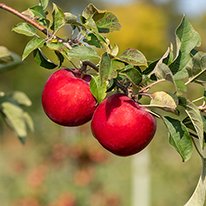
Kudos®
Limited Tree Availability, Fruit Expected in 2026
- Excellent crisp, juicy texture and a sweet, well balanced flavor with occasional tropical overtones
- Attractive, red fruit
- Fruit stores up to 5 months in common storage
- Ripens late September; similar to Honeycrisp or up to 1 week later
Late Season Apples
Honeygold
- Golden to yellow-green fruit that is sweet, crisp, and juicy
- Excellent for fresh eating and also good for cooking
- The fruit will store for 2 to 3 months
- The tree is easy to manage but susceptible to fire blight
- Ripens late September
Haralson
- Firm texture with a complex tart flavor
- Good for fresh eating and cooking, especially good pie apple
- The fruit will store for 4 to 5 months
- The tree is of low vigor and easily trained
- Tends to be biennial bearing
- Fruit may be prone to watercore and russeting
- Ripens late September to early October
Frostbite™
- Intensely sweet, firm and juicy flesh
- Stripped maroon-red and gold-yellow, 2 1/2" diameter fruit
- Fruit may be prone to russeting
- Excellent for cider
- Ripens late September to mid-October
Regent
- Appealing red-striped apple with a well-balanced flavor that is good for eating and cooking
- The fruit will store for 4 to 5 months
- Tree is moderately vigorous and easily trained
- Susceptible to apple scab and of moderate hardiness
- Ripens early to mid-October
SnowSweet®
- Savory, sweet tasting apple, with a slight tart balance and rich overtones
- Amazingly slow to turn brown when cut
- Appealing, large, bronze-red blush fruit
- Excellent for fresh eating, snack trays, and salads
- Ripens mid-October
Fireside/Connell Red
- Very large fruit with a sweet flavor and fine-grained flesh good for fresh eating, salad, and baked apples
- The tree is vigorous and weeping
- Ripens mid-October
Keepsake
- Very hard and crisp with yellow flesh and an exotic sweet, spicy flavor
- Good for fresh eating and cooking
- The fruit will store for 6 months
- The tree is of medium vigor and easy to manage
- Ripens mid-October
Prairie Spy
- Large, firm, dense fruit that is excellent for baking and long-term storage
- The tree is very vigorous and productive
- Ripens late October


